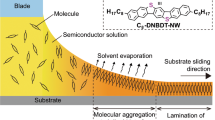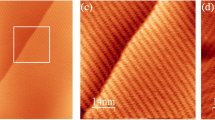Abstract
The future success of organic electronic devices strongly depends on the ability to tailor the properties of thin films and interfaces. This calls for well-ordered thin films. However, their properties are dominantly influenced by the formation of the first molecular layer representing a template for further growth. The development of the first layer—in turn—depends on the fine balance of molecule–substrate and molecule–molecule interaction. The latter is usually attractive owing to van der Waals forces and causes the formation of islands and small crystalline grains. Here, we report on organic adsorbates exhibiting a repulsive intermolecular interaction. With increasing coverage, Sn-phthalocyanine molecules continuously rearrange on Ag(111) in a series of ordered superstructures. They always fill the surface terraces homogeneously and maximize the domain size. Thicker films also exhibit extremely large, monocrystalline grains and potentially enable bulk-like properties for thin films. The intermolecular interaction can be tuned by cooling and becomes attractive below ∼120 K.
This is a preview of subscription content, access via your institution
Access options
Subscribe to this journal
Receive 12 print issues and online access
$209.00 per year
only $17.42 per issue
Buy this article
- Purchase on Springer Link
- Instant access to full article PDF
Prices may be subject to local taxes which are calculated during checkout




Similar content being viewed by others
References
Sun, Y. R. et al. Management of singlet and triplet excitons for efficient white organic light-emitting devices. Nature 440, 908–912 (2006).
Forrest, S. R. Ultrathin organic films grown by organic molecular beam deposition and related techniques. Chem. Rev. 97, 1793–1896 (1997).
Eremtchenko, M., Schaefer, J. A. & Tautz, F. S. Understanding and tuning the epitaxy of large aromatic adsorbates by molecular design. Nature 425, 603–605 (2003).
Schreiber, F. Structure and growth of self-assembling monolayers. Prog. Surf. Sci. 65, 151–256 (2000).
Hirose, Y., Forrest, S. R. & Kahn, A. Quasiepitaxial growth of the organic molecular semiconductor 3,4,9,10-perylenetetracarboxylic dianhydride. Phys. Rev. B 52, 14040–14047 (1995).
Rosei, F. et al. Properties of large organic molecules on metal surfaces. Prog. Surf. Sci. 71, 95–164 (2003).
Kilian, L., Umbach, E. & Sokolowski, M. Molecular beam epitaxy of organic films investigated by high resolution low energy electron diffraction (SPA-LEED): 3,4,9,10-perylenetetracarboxylicacid-dianhydride (PTCDA) on Ag(111). Surf. Sci. 573, 359–378 (2004).
Vazquez, H., Flores, F. & Kahn, A. Induced density of states model for weakly-interacting organic semiconductor interfaces. Org. Electron. 8, 241–248 (2007).
Ishii, H., Sugiyama, K., Ito, E. & Seki, K. Energy level alignment and interfacial electronic structures at organic/metal and organic/organic interfaces. Adv. Mater. 11, 605–625 (1999).
Hill, I. G., Rajagopal, A., Kahn, A. & Hu, Y. Molecular level alignment at organic semiconductor-metal interfaces. Appl. Phys. Lett. 73, 662–664 (1998).
Zou, Y. et al. Chemical bonding of PTCDA on Ag surfaces and the formation of interface states. Surf. Sci. 600, 1240–1251 (2006).
Park, Y. D., Lim, J. A., Lee, H. S. & Cho, K. Interface engineering in organic transistors. Mater. Today 10, 46–54 (2007).
Wang, S. D., Kanai, K., Ouchi, Y. & Seki, K. Bottom contact ambipolar organic thin film transistor and organic inverter based on C-60/pentacene heterostructure. Org. Electron. 7, 457–464 (2006).
Walzer, K., Maennig, B., Pfeiffer, M. & Leo, K. Highly efficient organic devices based on electrically doped transport layers. Chem. Rev. 107, 1233–1271 (2007).
Mitschke, U. & Bäuerle, P. The electroluminescence of organic materials. J. Mater. Chem. 10, 1471–1507 (2000).
Pfeiffer, M. et al. Doped organic semiconductors: Physics and application in light emitting diodes. Org. Electron. 4, 89–103 (2003).
Schneider, M., Umbach, E. & Sokolowski, M. Growth-dependent optical properties of 3,4,9,10-perylenetetracarboxylicacid-dianhydride (PTCDA) films on Ag(111). Chem. Phys. 325, 185–192 (2006).
Stahl, U., Gador, D., Soukopp, A., Fink, R. & Umbach, E. Coverage-dependent superstructures in chemisorbed NTCDA monolayers: A combined LEED and STM study. Surf. Sci. 414, 423–434 (1998).
Kilian, L. et al. The commensurate-to-incommensurate phase transition of an organic monolayer: A high resolution LEED analysis of the superstructures of NTCDA on Ag(111). Surf. Sci. 602, 2427–2434 (2008).
Umbach, E., Sokolowski, M. & Fink, R. Substrate-interaction, long range order and epitaxy of large organic adsorbates. Appl. Phys. A 63, 565–576 (1996).
Glöckler, K. et al. Highly ordered structures and submolecular scanning tunnelling microscopy contrast of PTCDA and DM-PBDCI monolayers on Ag(111) and Ag(110). Surf. Sci. 405, 1–20 (1998).
Temirov, R., Soubatch, S., Luican, A. & Tautz, F. S. Free-electron-like dispersion in an organic monolayer film on a metal substrate. Nature 444, 350–353 (2006).
Lackinger, M., Griessl, S., Heckl, W. M. & Hietschold, M. Coronene on Ag(111) investigated by LEED and STM in UHV. J. Phys. Chem. B 106, 4482–4485 (2002).
Fernandez-Torrente, I. et al. Long-range repulsive interaction between molecules on a metal surface induced by charge transfer. Phys. Rev. Lett. 99, 176103 (2007).
Yokayama, T., Takahashi, T., Shinozaki, K. & Okamoto, M. Quantitative analysis of long-range interactions between adsorbed dipolar molecules on Cu(111). Phys. Rev. Lett. 98, 206102 (2007).
Langner, A., Hauschild, A., Fahrenholz, S. & Sokolowski, M. Structural properties of tetracene films on Ag(111) investigated by SPA-LEED and TPD. Surf. Sci. 574, 153–165 (2005).
Gonella, G., Dai, H.-L. & Rockey, T. J. Tetracene monolayer and multilayer thin films on Ag(111): Substrate-adsorbate charge-transfer bonding and inter-adsorbate interaction. J. Phys. Chem. C 112, 4696–4703 (2008).
Pawin, G., Wong, K. L., Kwon, K.-Y. & Bartels, L. A homomolecular porous network at a Cu(111) surface. Science 313, 961–962 (2006).
de Paola, R. A., Hoffmann, F. M., Heskett, D. & Plummer, E. W. Absorption of molecular nitrogen on clean and modified Ru(001) surfaces—the role of sigma-bonding. Phys. Rev. B 35, 4236–4249 (1987).
Penka, V., Christmann, K. & Ertl, G. Ordered low-temperature phases in the H/Ni(110) system. Surf. Sci. 136, 307–318 (1984).
Lukas, S., Witte, G. & Wöll, Ch. Novel mechanism for molecular self-assembly on metal substrates: Unidirectional rows of pentacene on Cu(110) produced by a substrate-mediated repulsion. Phys. Rev. Lett. 88, 028301 (2002).
McKeown, B. B. Phthalocyanine Materials (Cambridge Univ. Press, 1998).
Fukagawa, H., Yamane, H., Kera, S., Okudaira, K. K. & Ueno, N. Experimental estimation of the electric dipole moment and polarizability of titanyl phthalocyanine using ultraviolet photoelectron spectroscopy. Phys. Rev. B 73, 041302(R) (2006).
Mannsfeld, S. C. B. & Fritz, T. Analysis of the substrate influence on the ordering of epitaxial molecular layers: The special case of point-on-line coincidence. Phys. Rev. B 69, 075416 (2004).
Lackinger, M. & Hietschold, M. Determining adsorption geometry of individual tin–phthalocyanine molecules on Ag(111)—a STM study at submonolayer coverage. Surf. Sci. 520, L619–L624 (2002).
Stadler, C. et al. Structural investigation of the adsorption of SnPc on Ag(111) using normal-incidence X-ray standing waves. Phys. Rev. B 74, 035404 (2006).
Acknowledgements
We thank F. Pollinger and the ESRF staff (T.-L. Lee, J. Zegenhagen) for their help during the XSW experiments. Financial support by the BMBF, the DFG and the ESRF is acknowledged.
Author information
Authors and Affiliations
Contributions
C.S. carried out all SPA-LEED experiments. S.H. participated in measurements on SnPc and I.K. in those on CuPc. XSW measurements were carried out by C.S., C.K., S.H. and I.K., and analysed by C.S. The experiments, data analysis and the manuscript were intensively discussed by C.S., C.K. and E.U. The paper was written by C.S. and C.K.
Corresponding author
Rights and permissions
About this article
Cite this article
Stadler, C., Hansen, S., Kröger, I. et al. Tuning intermolecular interaction in long-range-ordered submonolayer organic films. Nature Phys 5, 153–158 (2009). https://doi.org/10.1038/nphys1176
Received:
Accepted:
Published:
Issue Date:
DOI: https://doi.org/10.1038/nphys1176



